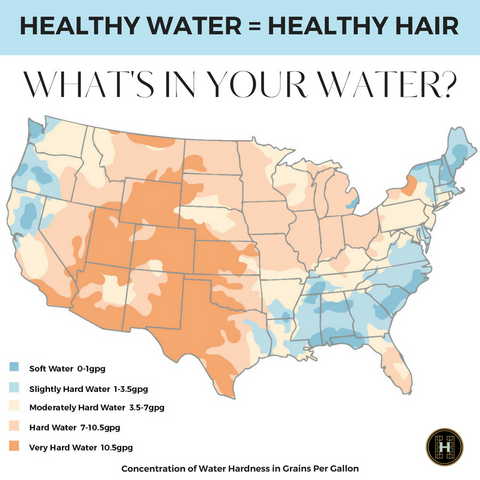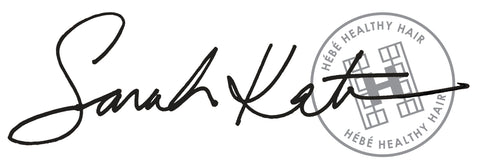Healthy Water = Healthy Hair
Hello Healthy Hair Tribe!
Your hair is lifeless, brittle, dull and thinning…You have changed products: shampoos, conditioners, treatments and serums but you don’t see any difference. I hear this daily from new clients!
When we search for healthy hair solutions, we typically search for the products above to help us. But have you ever considered the water you use to wash your hair can affect your hair health? We’ve heard stories about hard water, soft water, polluted water and chlorinated water. But do you really understand what this means for your hair? This map demonstrates that most of us live with very hard to moderately hard water.

Hard water has high mineral content (in contrast with "soft water") and is formed when water percolates through deposits of limestone and chalk which are largely made up of calcium and magnesium carbonates (from Wikipedia, the free encyclopedia). While hard water may be safe for consumption, it does not taste very good!
If it can destroy our plumbing and coat our showers, just think what it is doing to our hair! The minerals that cause buildup in our pipes and showers also build up on our hair and scalp causing our scalp to be dry and flaky and our hair to look dull, lifeless, dry and brittle. You can shampoo, condition and use hair treatments but if you don’t address your water, you will stay in that vicious cycle of unhealthy hair.
What is the first step to healthy water?
Step 1 - Test our water. Knowing what is in our water helps us take the necessary steps to remove chlorine and reduce the mineral levels effectively. Test kits can be bought at any pool supply store, online stores and some municipalities offer them free of charge. I recommend the “Just Add Water” Testing Kit from Malibu. Click HERE to purchase. These two quick and easy tests are beneficial for everyone exposed to hard water.
What if your test shows moderate to high levels of Chlorine and Minerals?
Step 2 - Remove the chlorine. You can remove the chlorine by installing a shower head water filter that removes 100% of the chlorine. Most shower head water filters in the market remove anywhere between 35%-85% of the chlorine and they do not remove minerals. Unfortunately, I have found that as a consumer, it is very difficult to know how much chlorine is actually removed. This is where our money can be going down the drain literally… I recommend testing your water before and after installation and making sure you can return the filter if you are not happy with the results. I only recommend a filter with Vitamin C. Our shower filter is great because it removes 100% of chlorine, reduces minerals and sanitizes the water. It also softens, helps moisturize and deodorize the hair with its ceramic bead technology. It has anti-aging benefits that firm and moisturize our hair, skin and body with its collagen filter (our body is made up of 30% collagen/protein). It uses 65% less water and gives you 400% more pressure. You can check it out HERE.
A shower head water filter is easy to install too – you do not need a plumber! Once you have your filter installed, pull out that handy water test kit that I recommended in Step 1 and check your water again to ensure it is working properly. Filters will need to be changed regularly and they should indicate how often, i.e. 30,000 - 65,000 gallons but the timeframe can vary due to usage.
Step 3 - Remove the mineral buildup on your hair and scalp. At Hébé Healthy Hair Bar, the foundation of all our services is our Signature SOS Hair Rescue Treatment. The SOS treatment removes hard water and chlorine deposits from our hair leaving it brighter, shinier, softer, smoother and healthier. To break the cycle of dry, brittle, and unhealthy hair, the SOS treatment should be performed in conjunction with your hair color appointment and at least every 3 months. To find a salon that uses the same technology in your area, click here and request a “Crystal Gel Service”.
Step 4 - Replace the mineral buildup with plant based protein. We all have porous hair from (at least) the middle of our hair shaft down through our ends if we color, blow dry, flat iron, or curl our hair. We also get over porous hair from over processing color, sun exposure, hard water and chlorine. What does porous hair mean to hair health? Imagine that our hair looks like a sponge. Sponge holes get filled up with minerals from hard water and chlorine as they like to bury deep into the holes of our hair and act like a glue-like substance that holds our hair together. It’s not a “good” glue, it’s a “bad” glue that will cause breakage, tangling, matting, split ends, brittleness and dryness.
If we remove minerals and chlorine from the deep pockets of our hair and we don’t fill those holes with “good” glue then they will quickly build up again with “bad” glue and continue to compromise our hair. My favorite products to help fill our porous ends at home are Ekatala’s Deep Conditioning Mask and Organic Silk Serum Cocktail.
Step 5 – Shampoo less frequently. Why? The shampoo we use traps dirt and oils and washes them away, leaving our hair and scalp dry. Our body produces sebum (or oil) naturally to help protect our scalp after we shampoo. If you can brave it out and get through a 2 to 4-week adjustment period, you will soon be happy to notice your hair becoming less dry, your scalp less oily and have overall more hair manageability.
Step 6 - Use dry shampoos. Not only do dry shampoos allow us to wash less often, they are a great post-gym fix, travel companion and help with styling – especially in humid or wet weather. Dry shampoo can also help give you lift when your hair is looking limp. TIP** If you want shower fresh hair in the morning, apply dry shampoo before bed and let it work overnight to absorb oils. You will wake with a fresh mane! I love to use HEALTHY HAIR NECTAR GROW as a dry shampoo. In addition to all of their healthy hair benefits, they reduce sebum and provide lots of volume!
Let’s recap. We’ve learned that the water we use to wash our hair can be the culprit to dry, lifeless, brittle hair and thin hair. These are the steps we should take to win the water war for good!
Step 1 – Test Your Water
Step 2 – Remove Chlorine
Step 3 – Remove Mineral Buildup on Your Hair & Scalp
Step 4 – Replace Mineral Buildup with Plant Based Protein
Step 5 – Shampoo Less Frequently
Step 6 – Use Dry Shampoo
Wishing You Lots of Healthy Hair Love!



21 comments
xYLQPmIuTMrEJSA
GnbqjALBdVJQoxlu
bCWUMRLempsoyjdQ
dSYevPVrZpkWzqI
yuqrlHdfLebcj